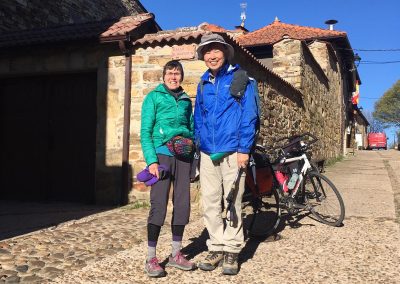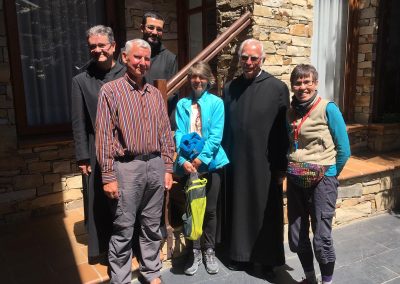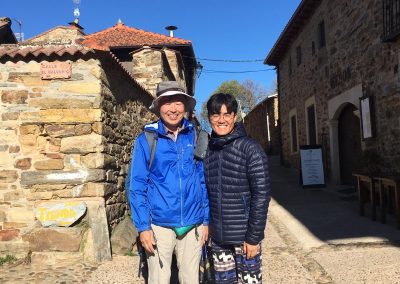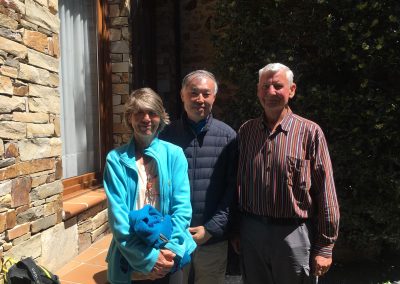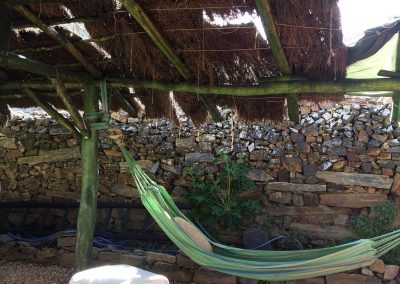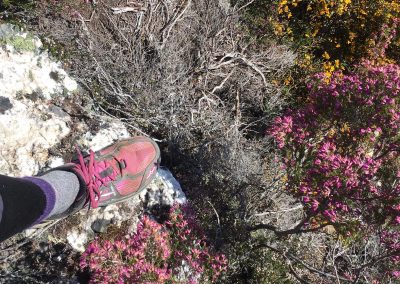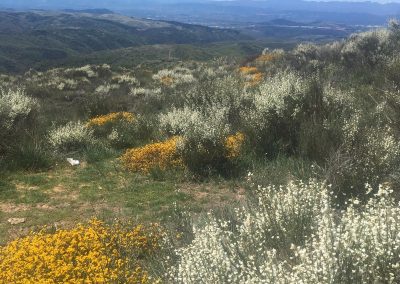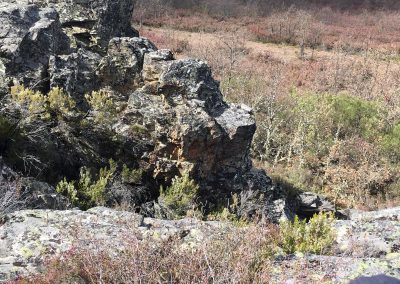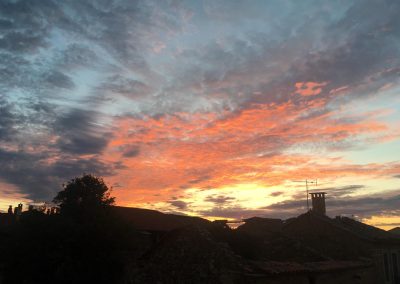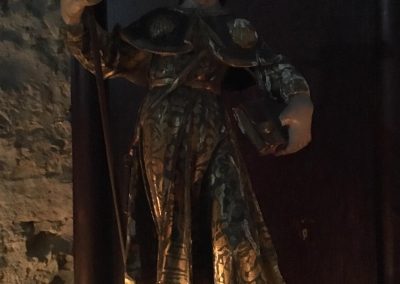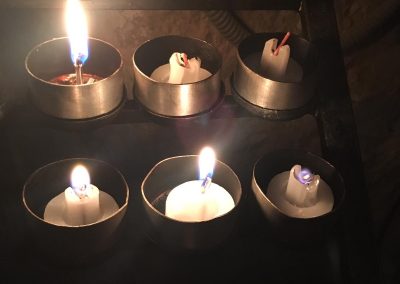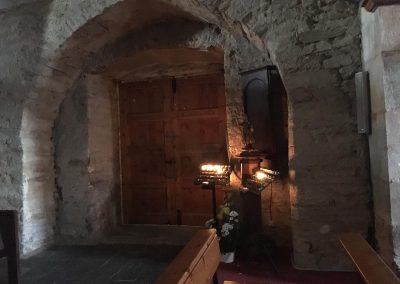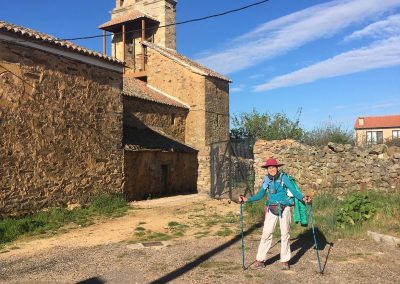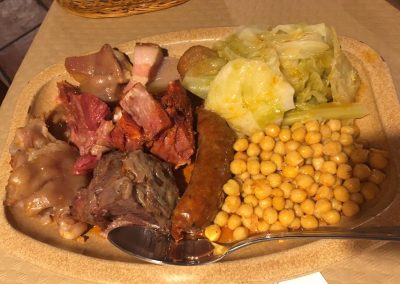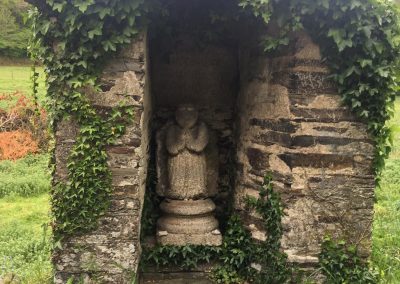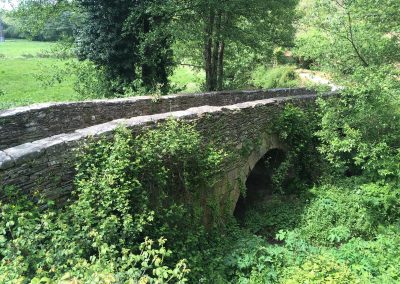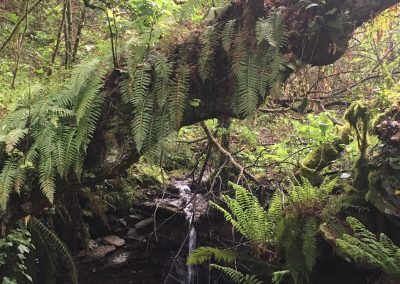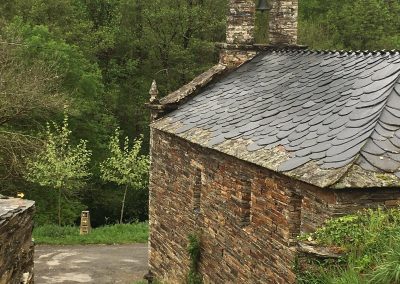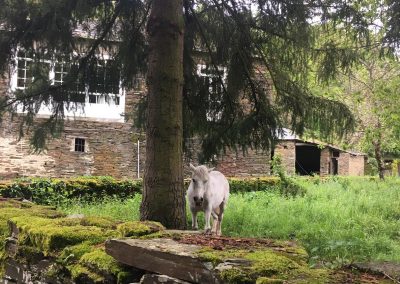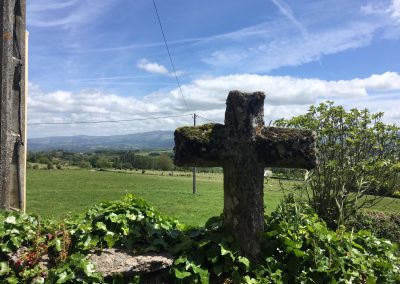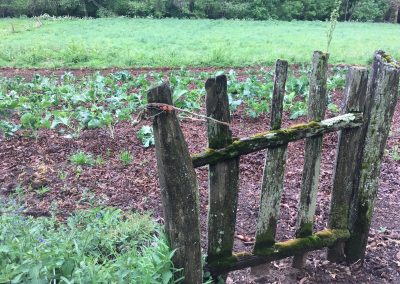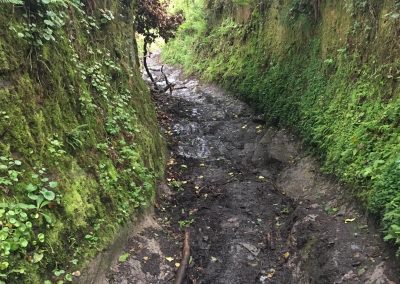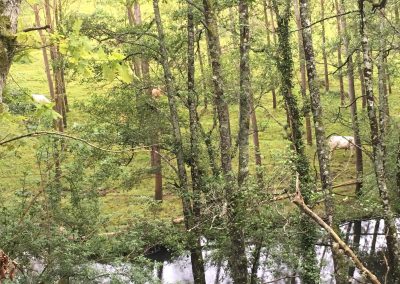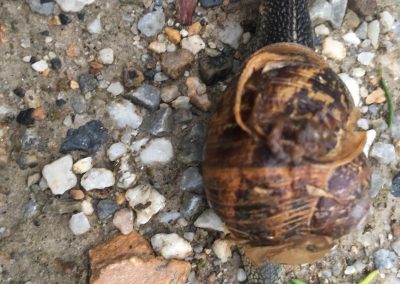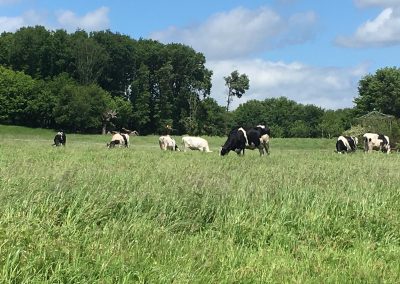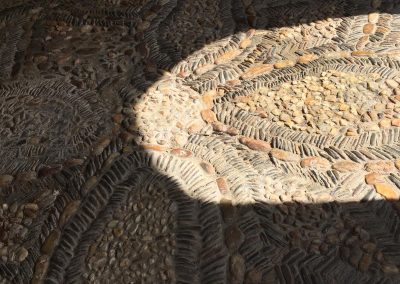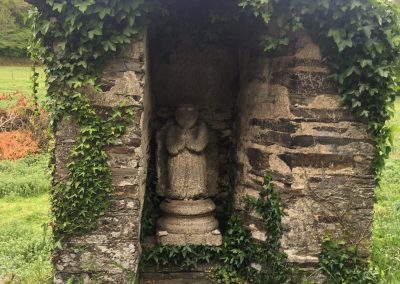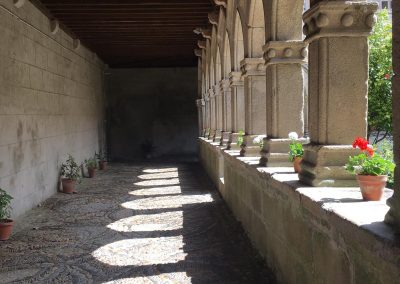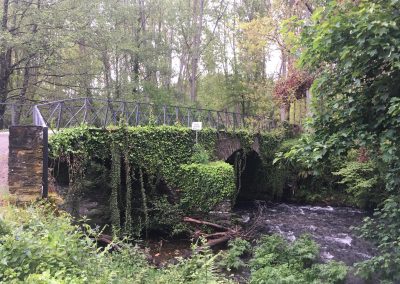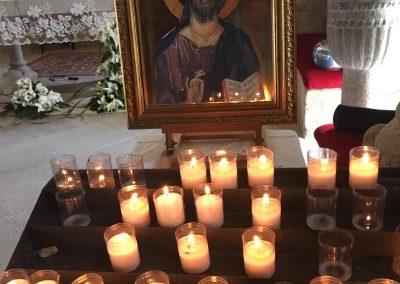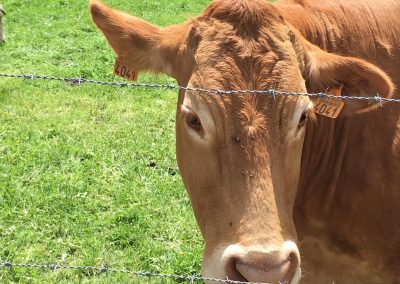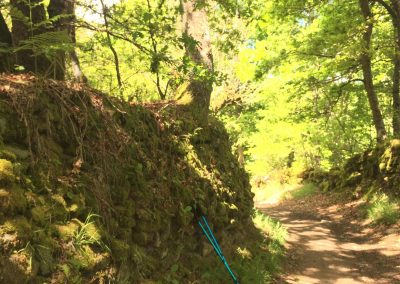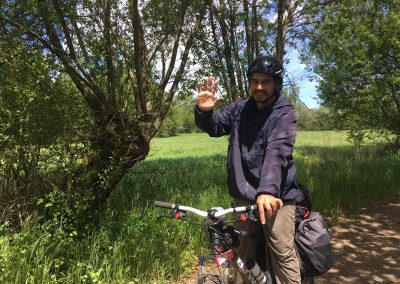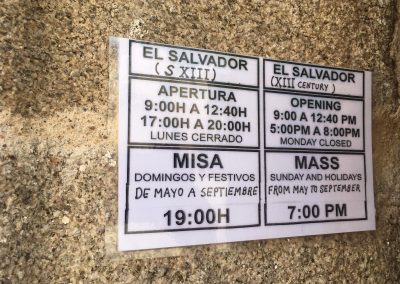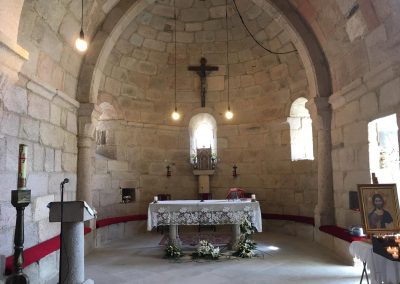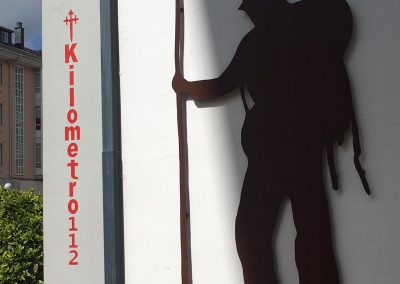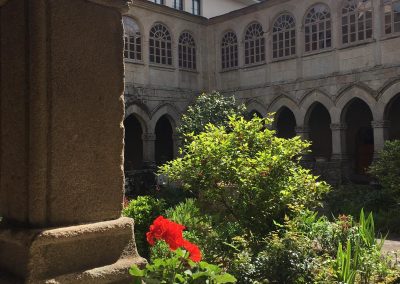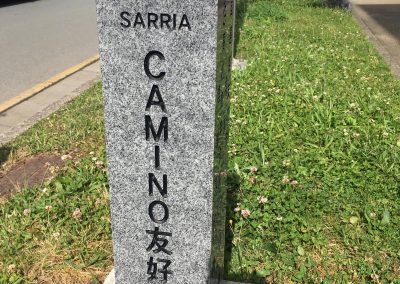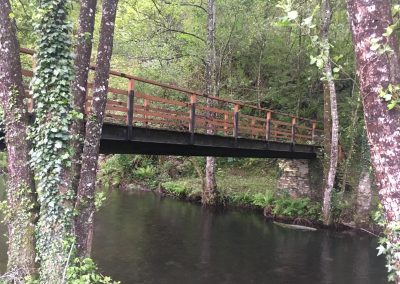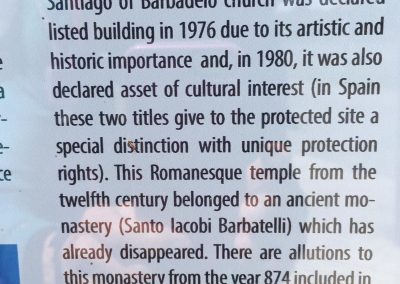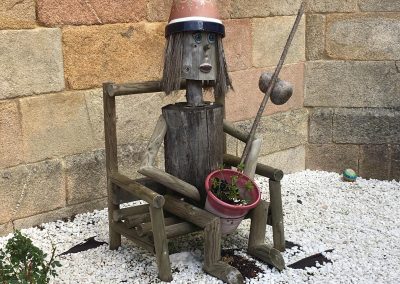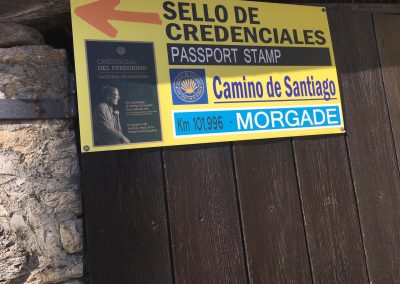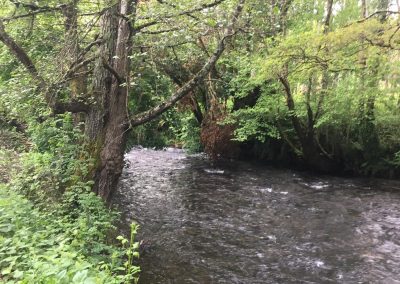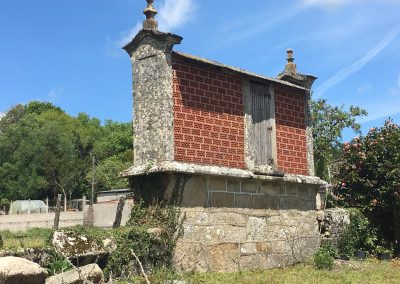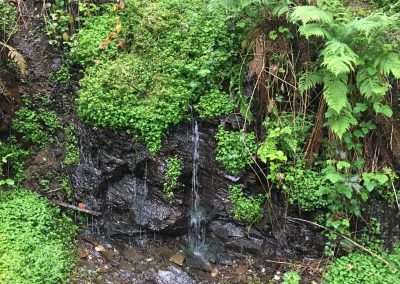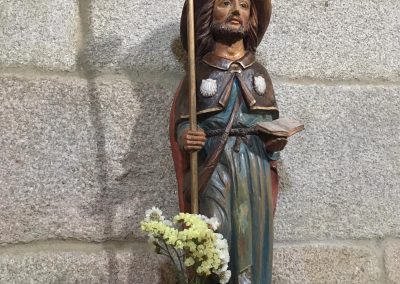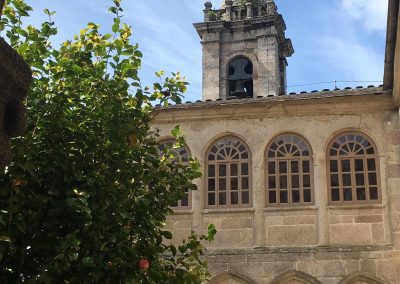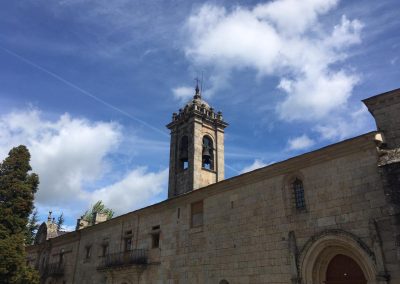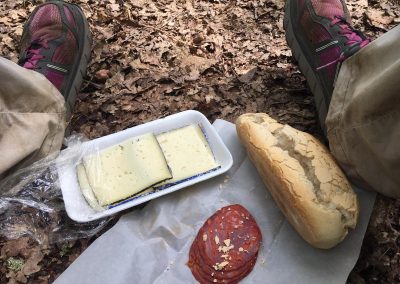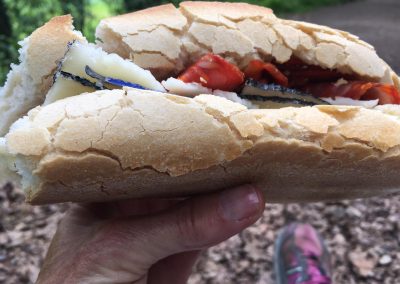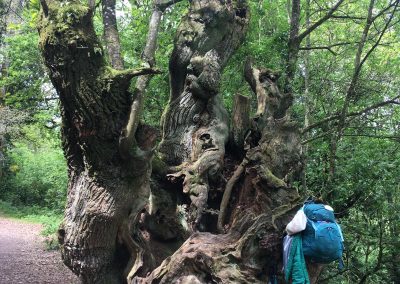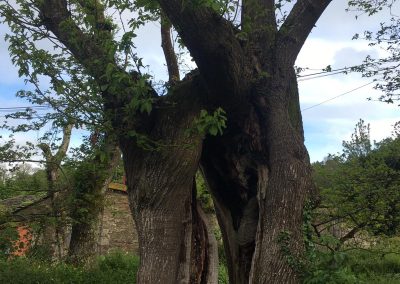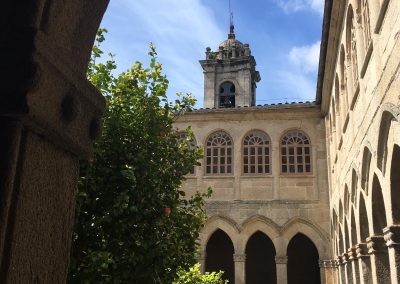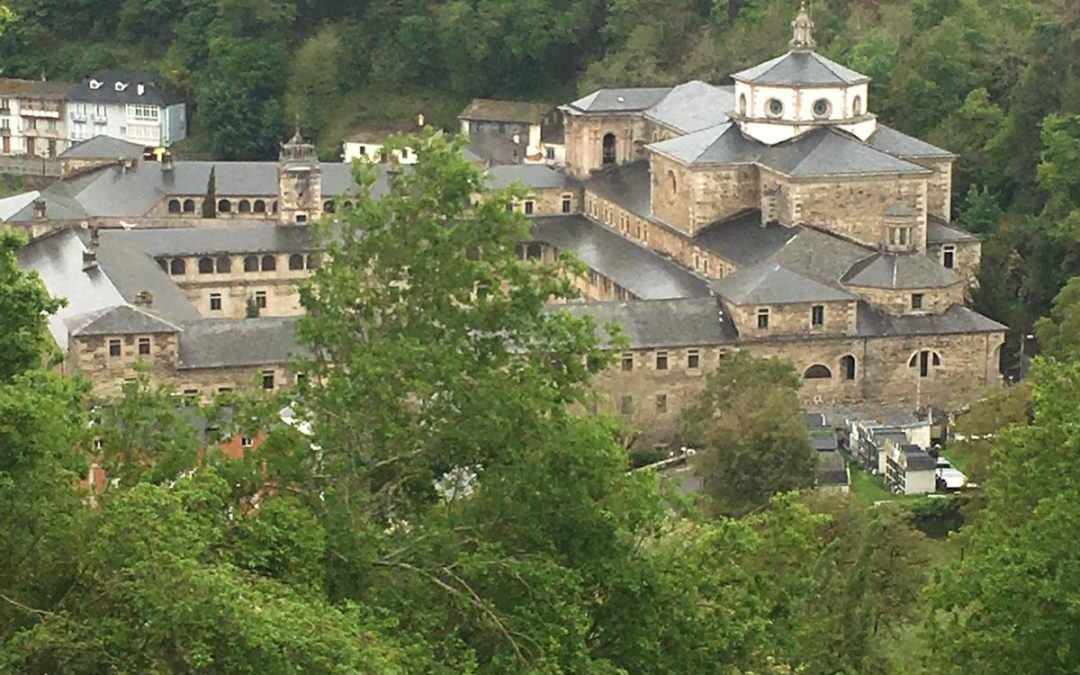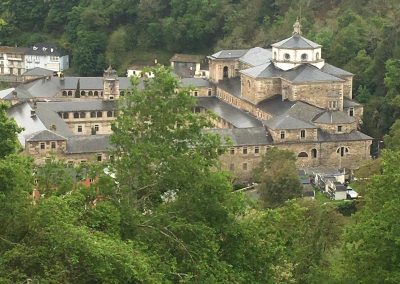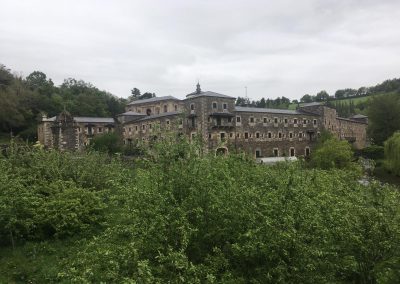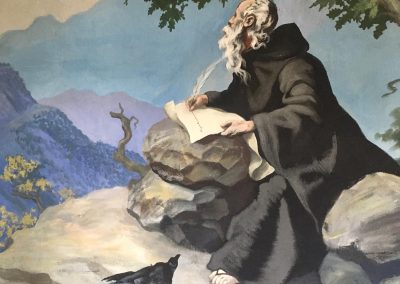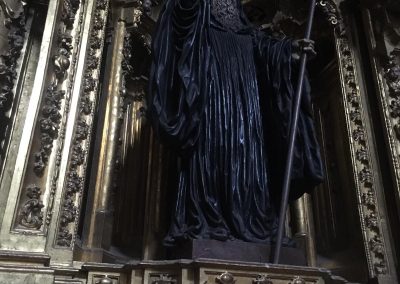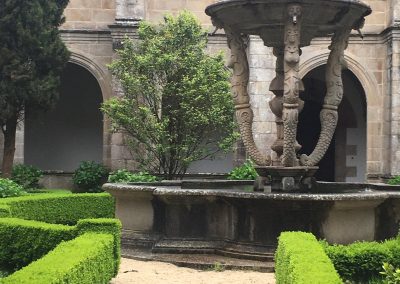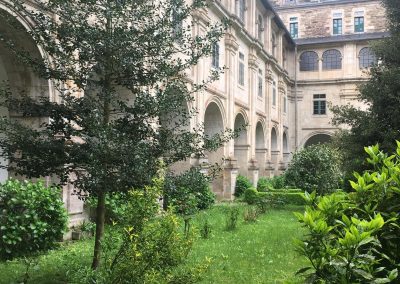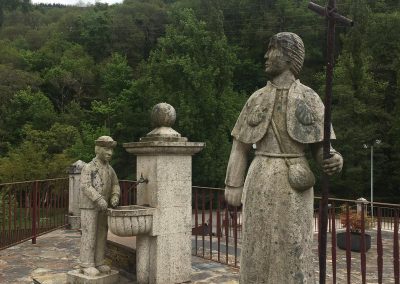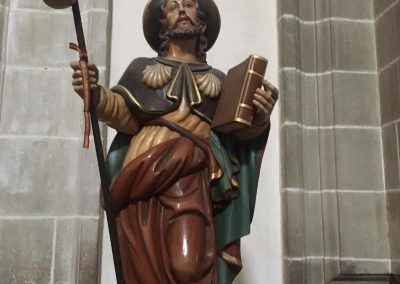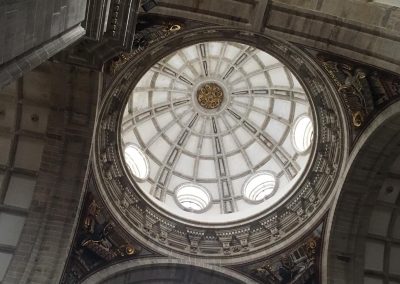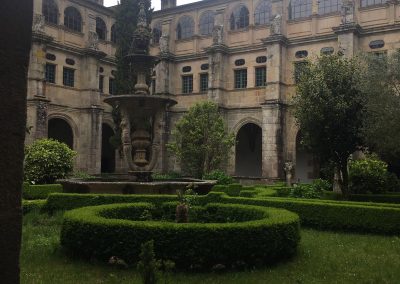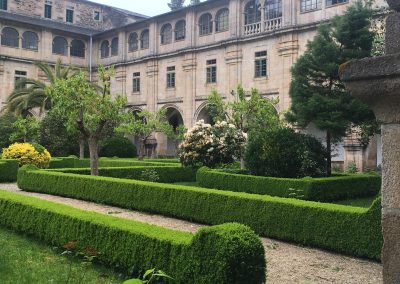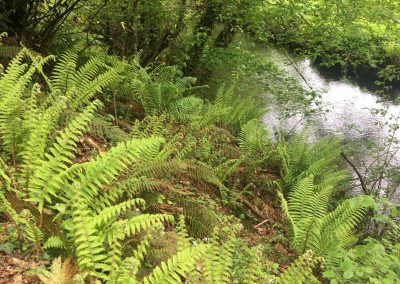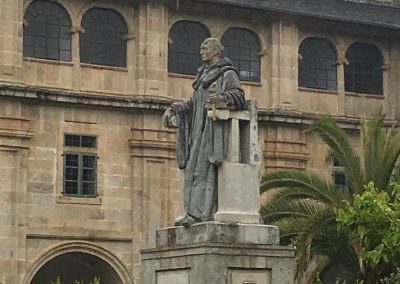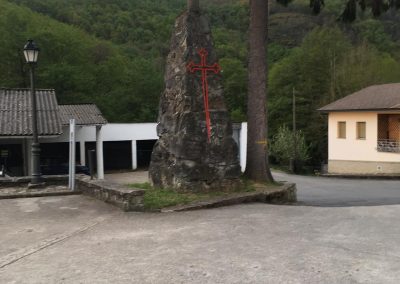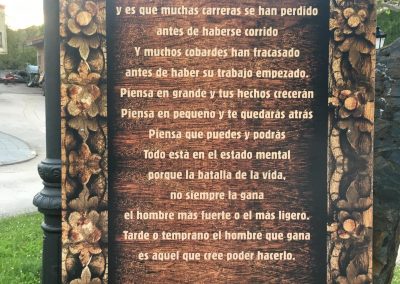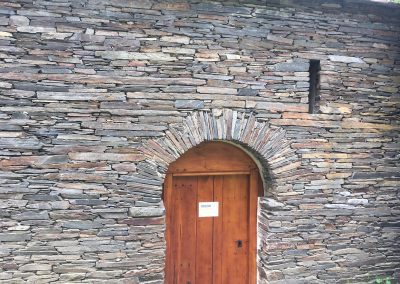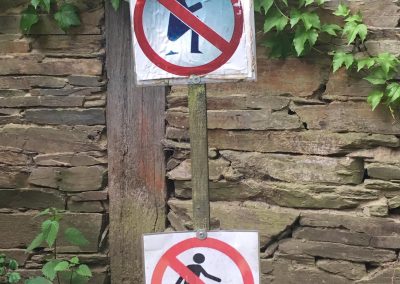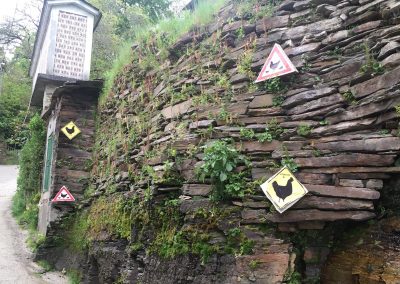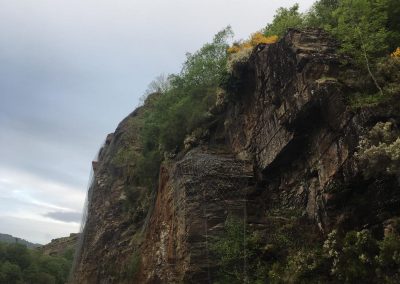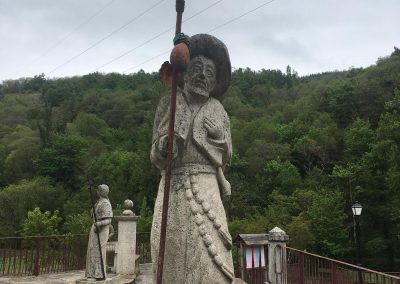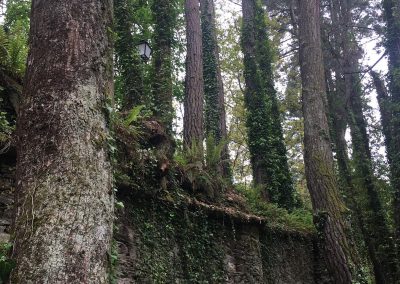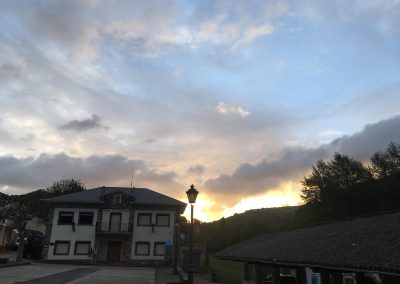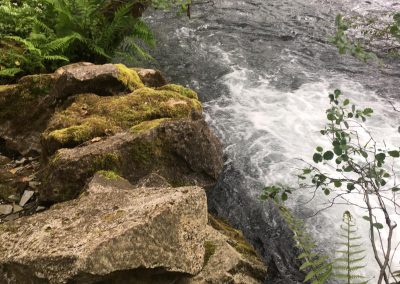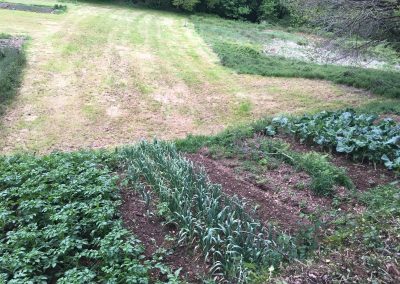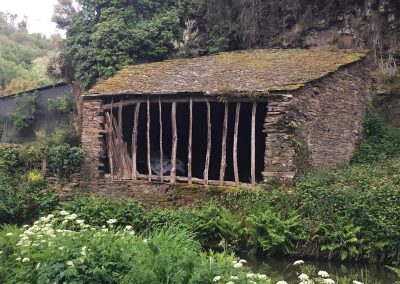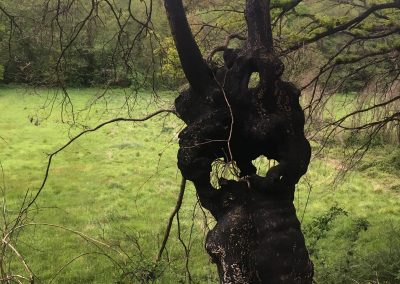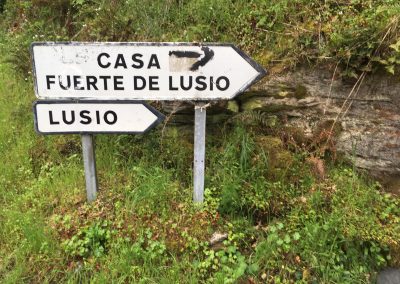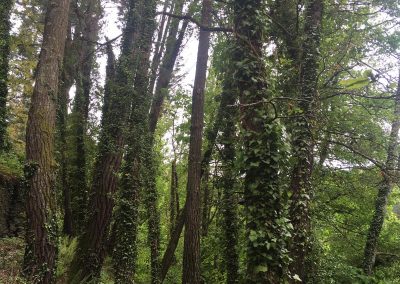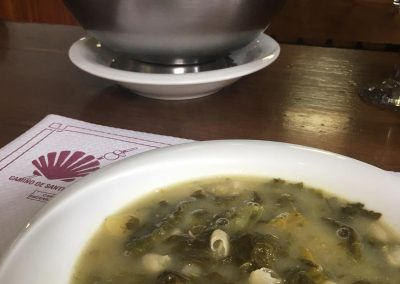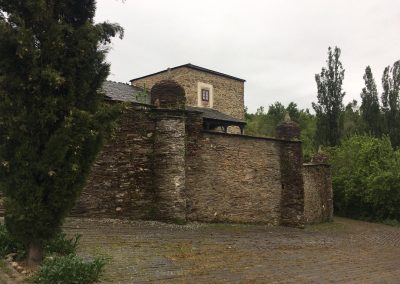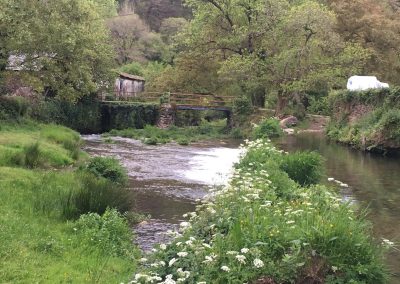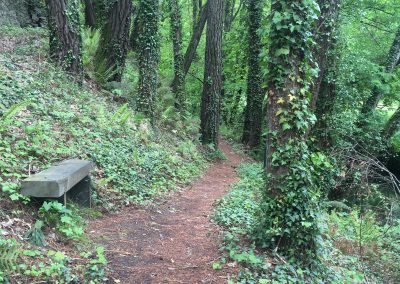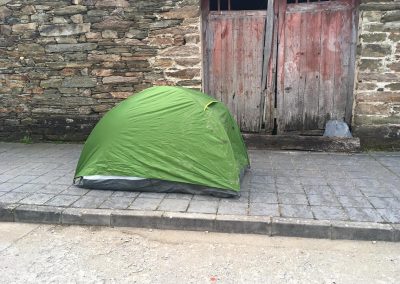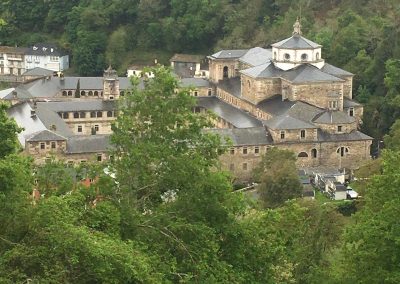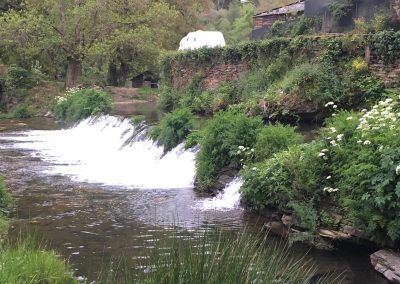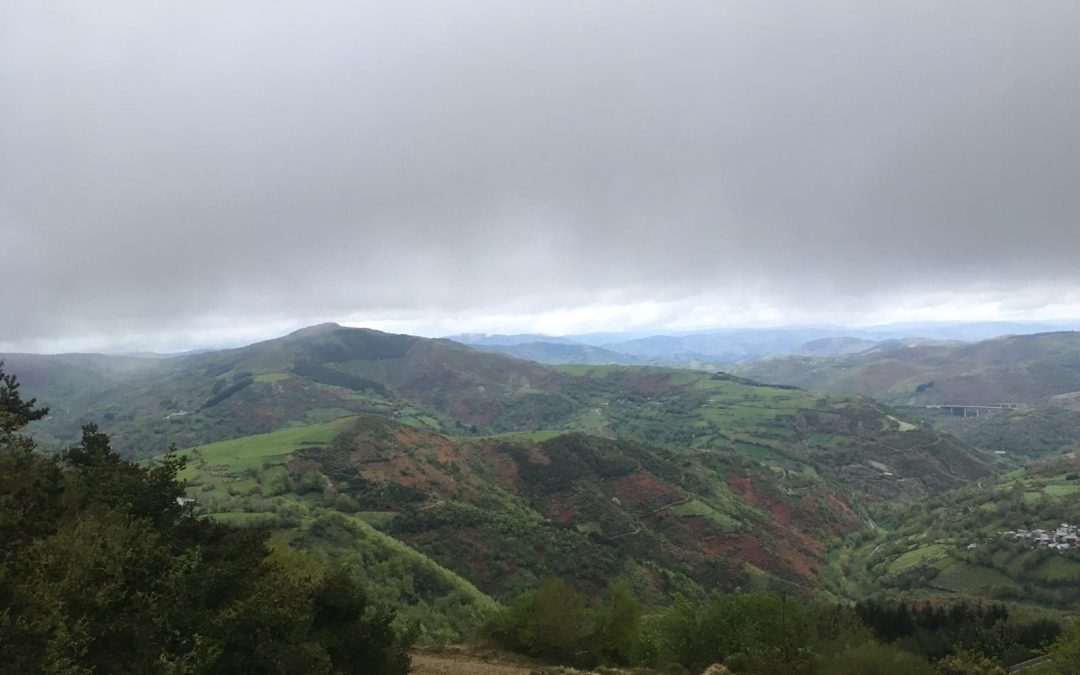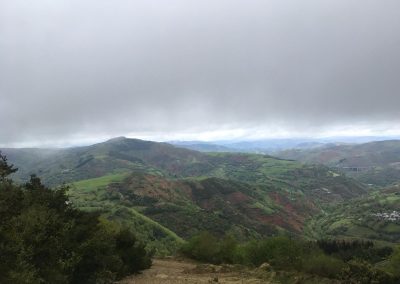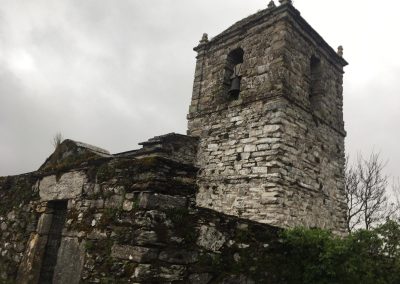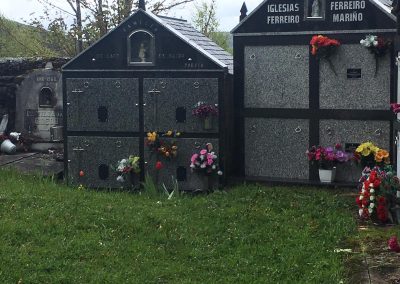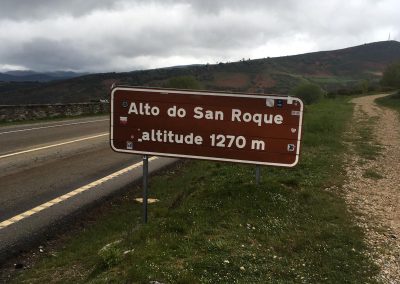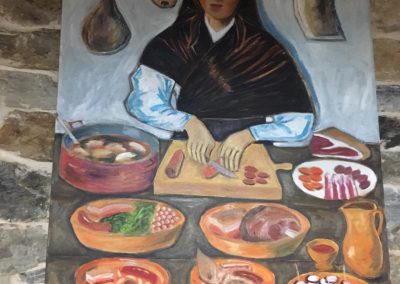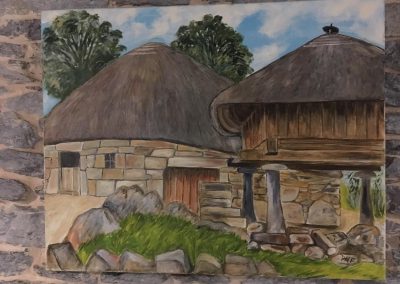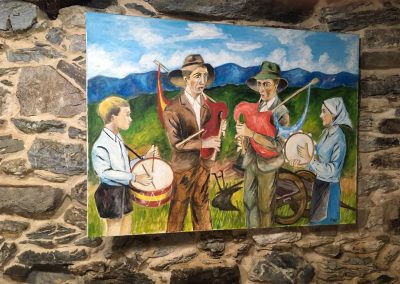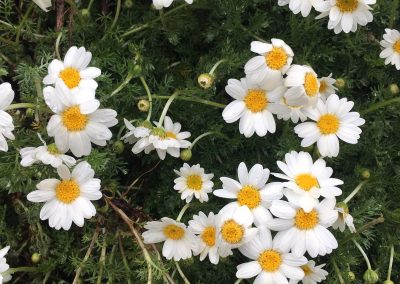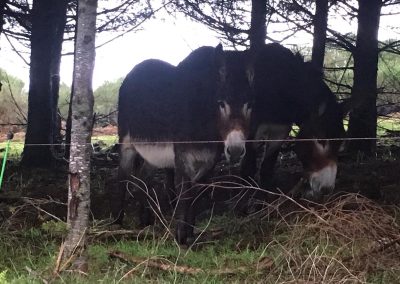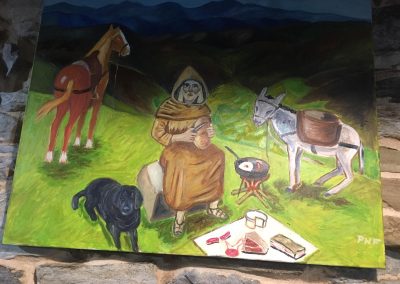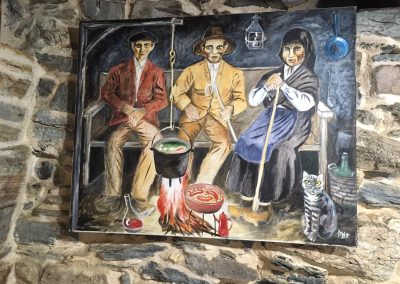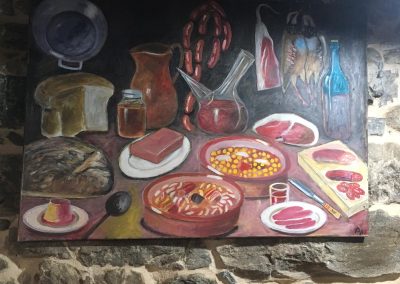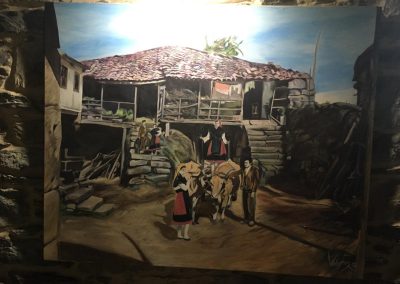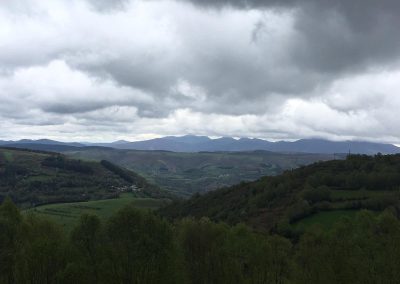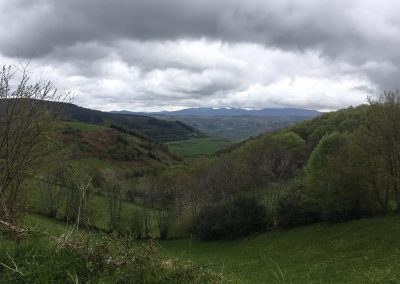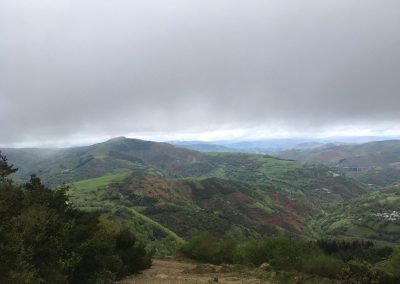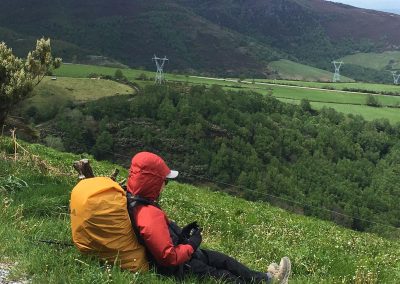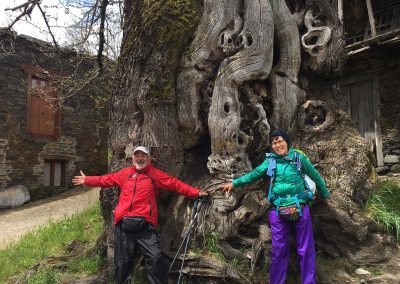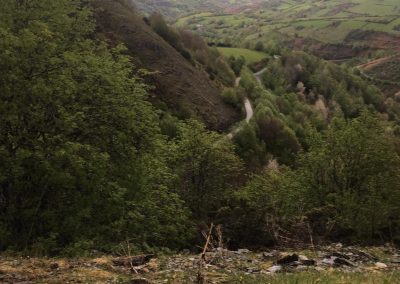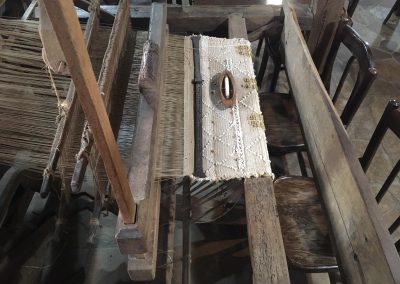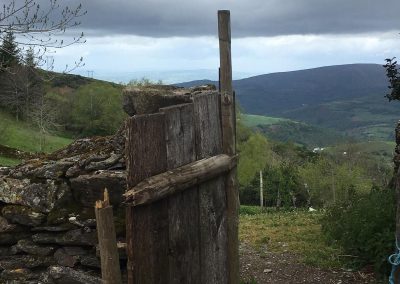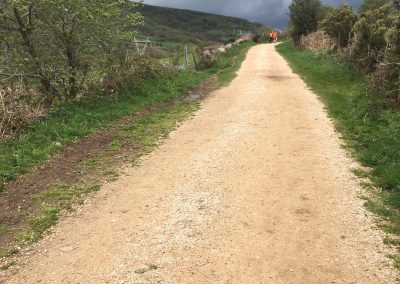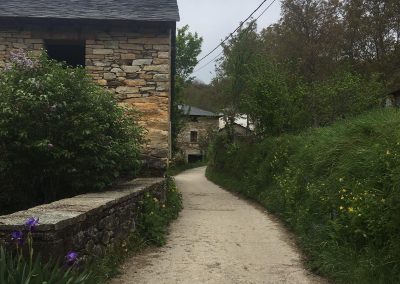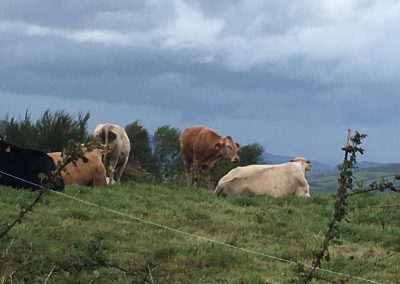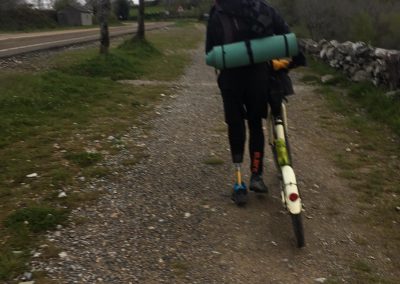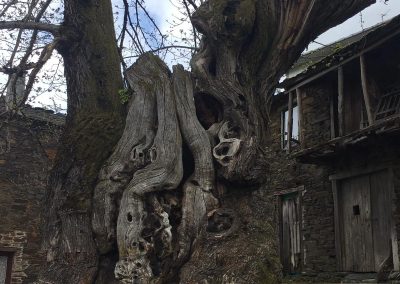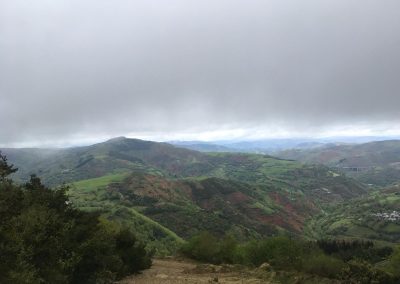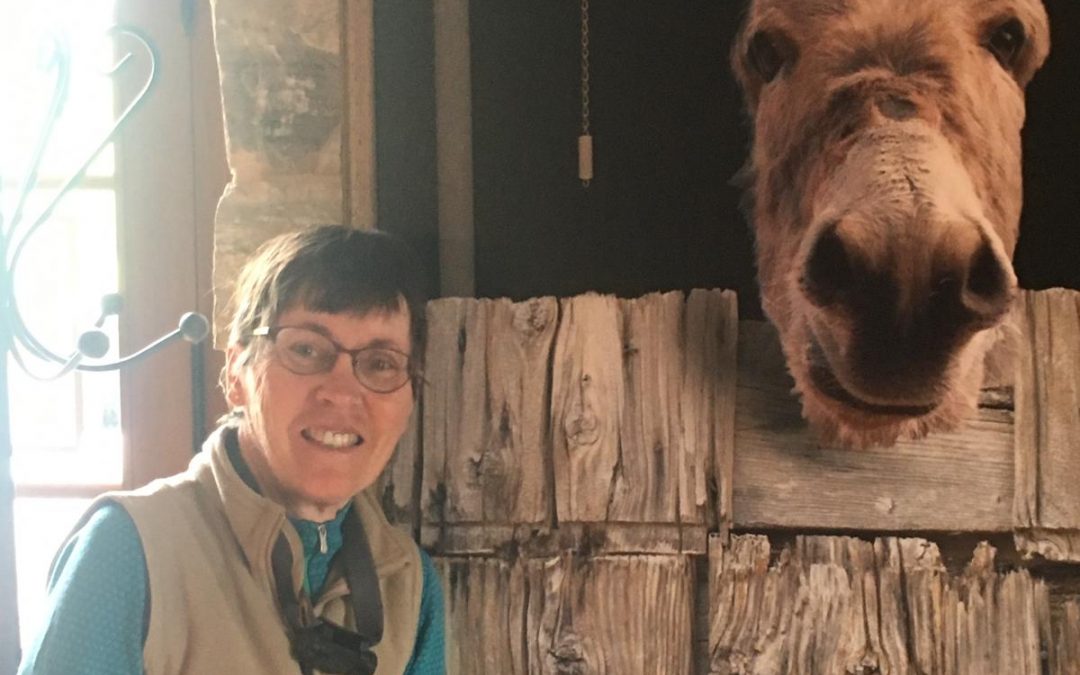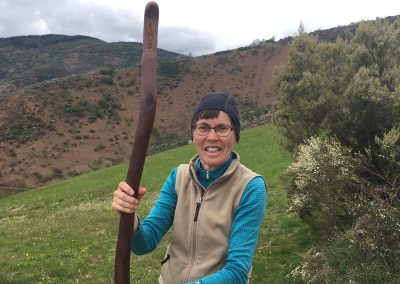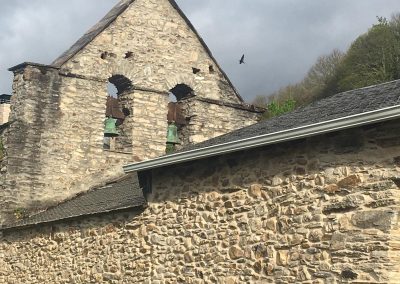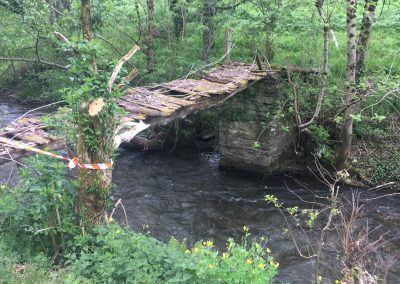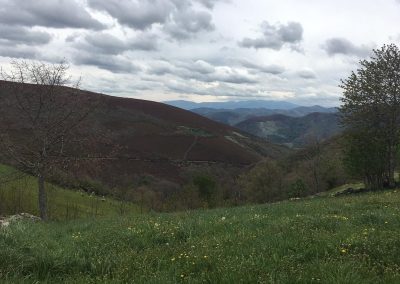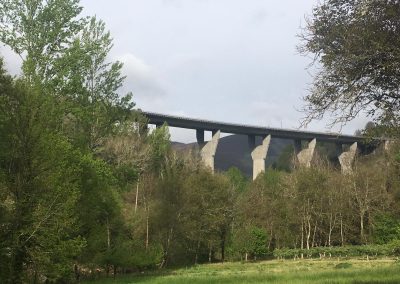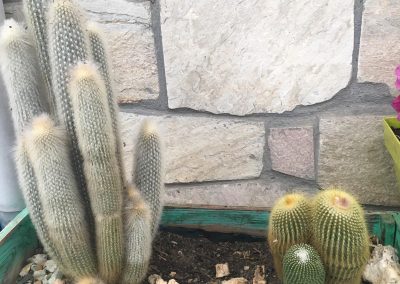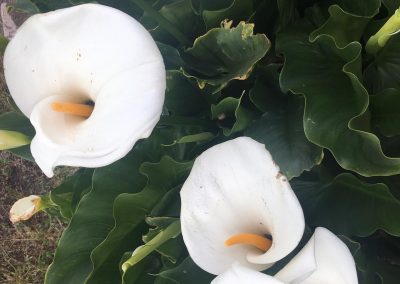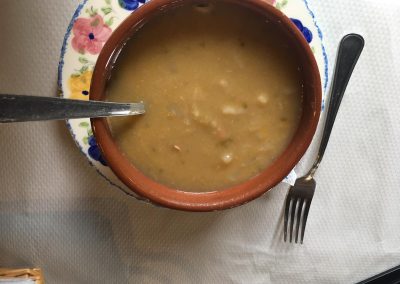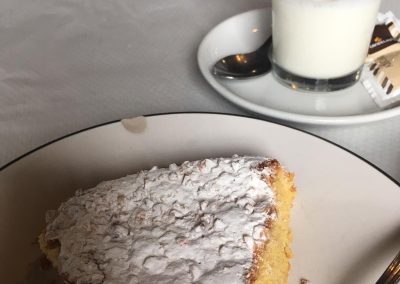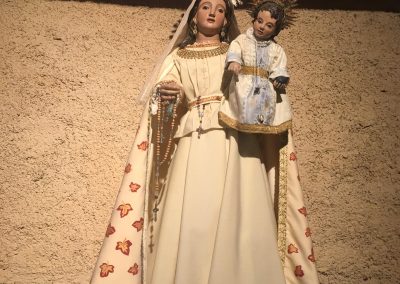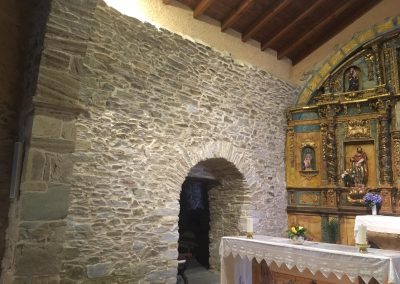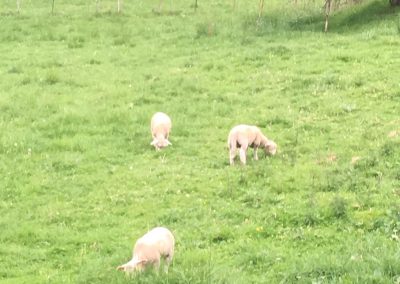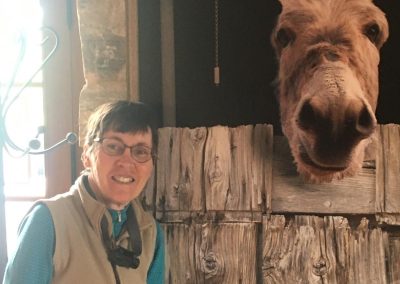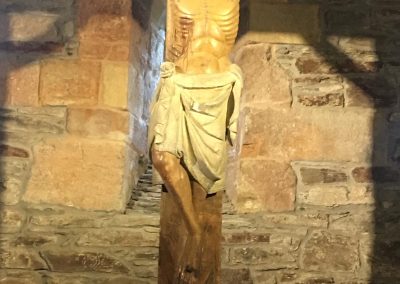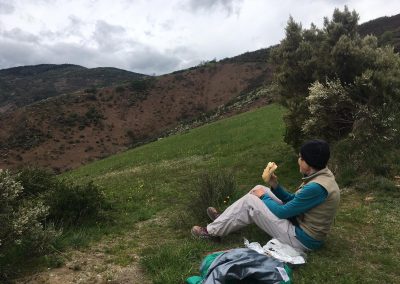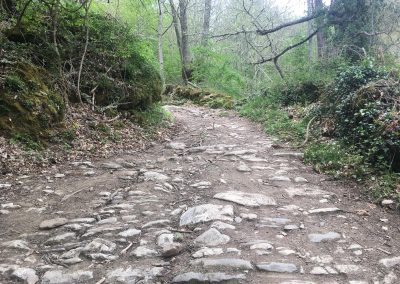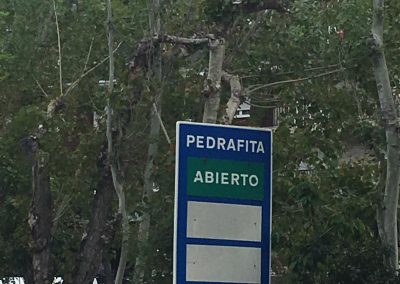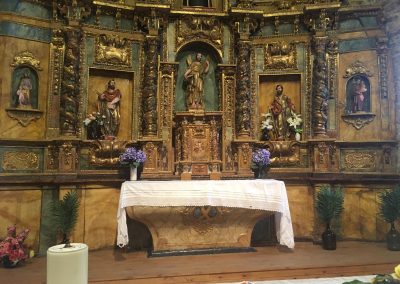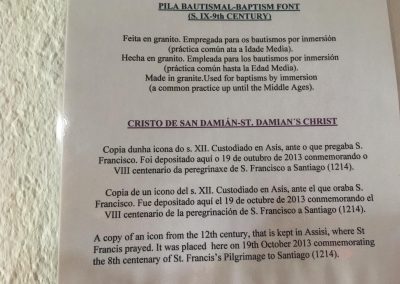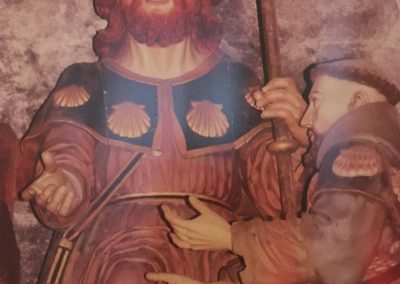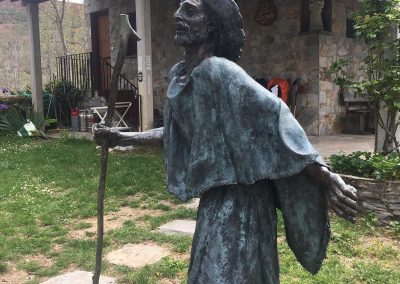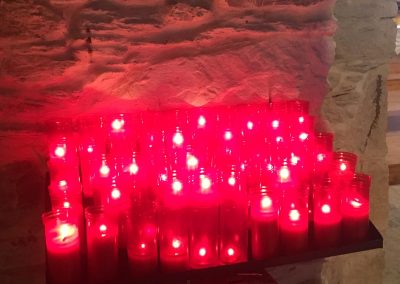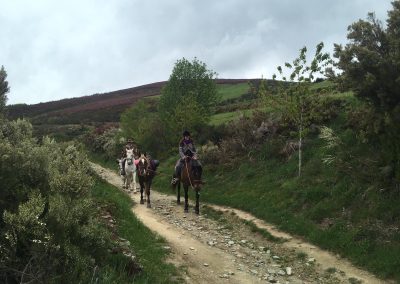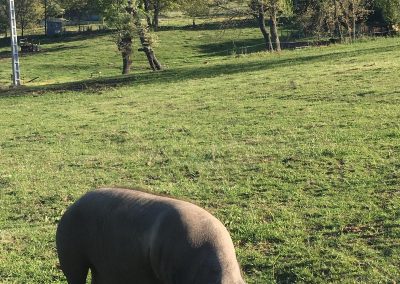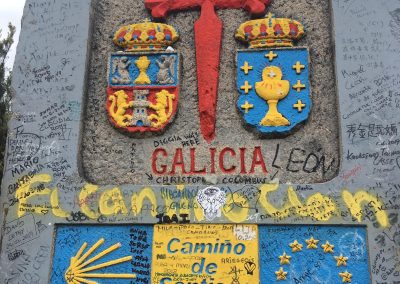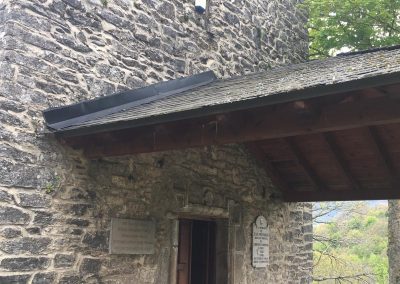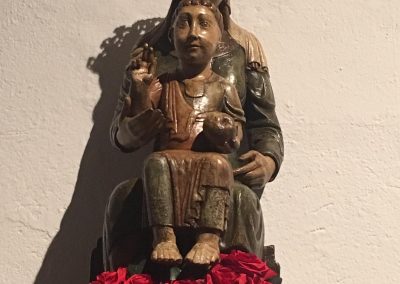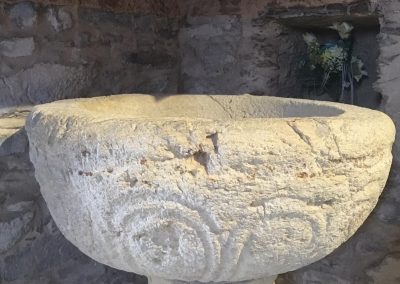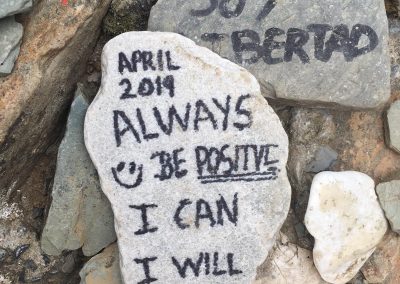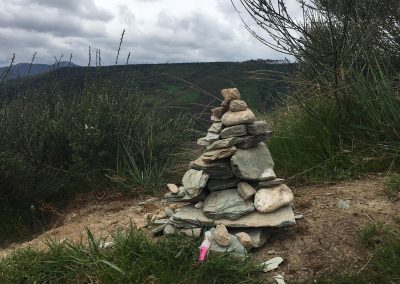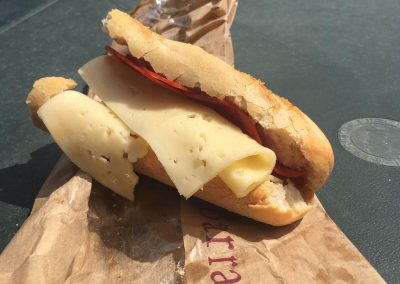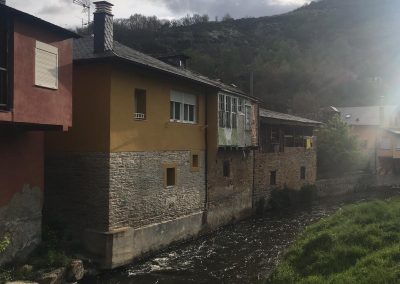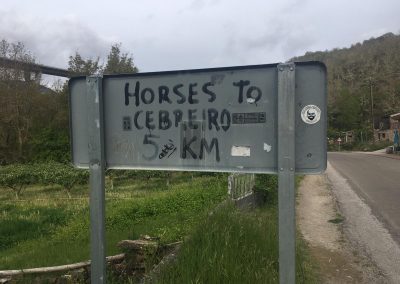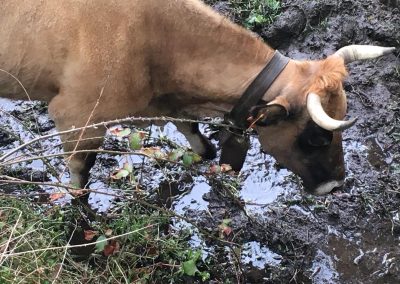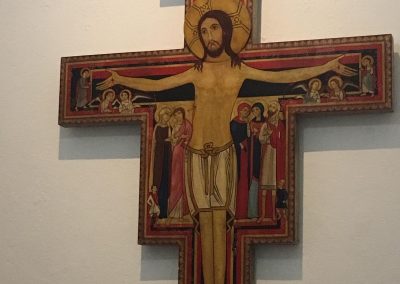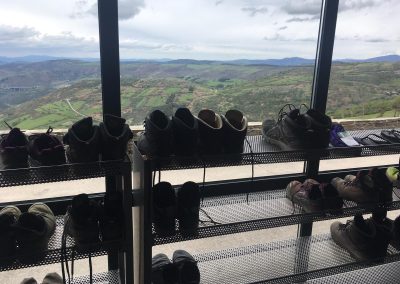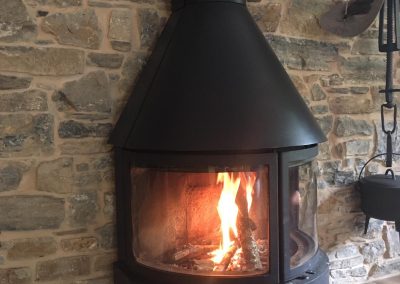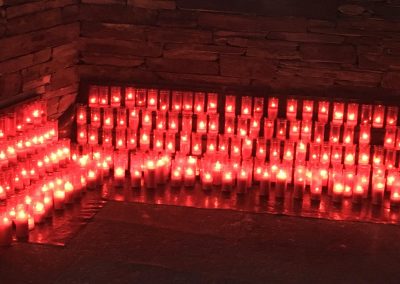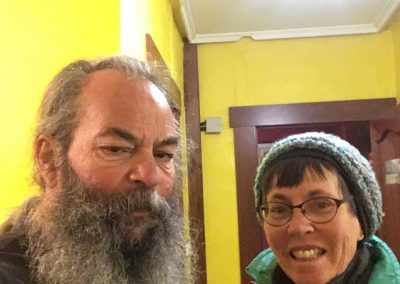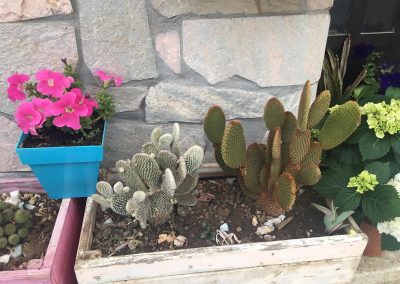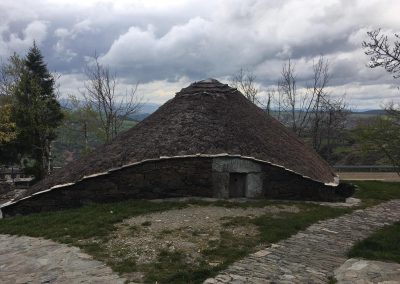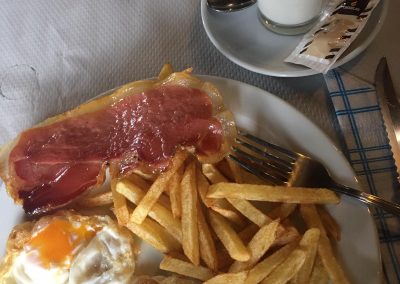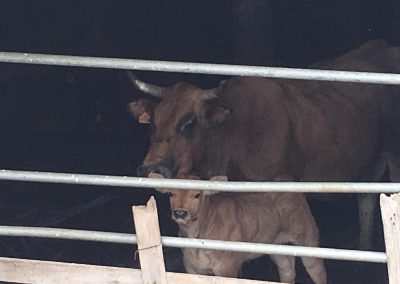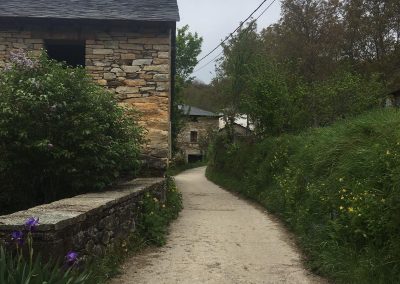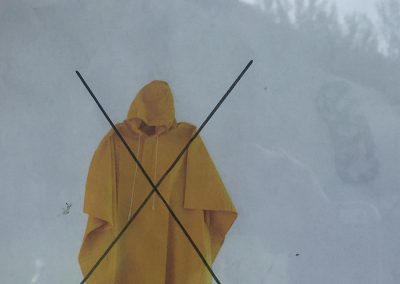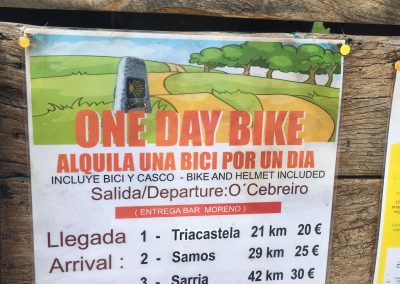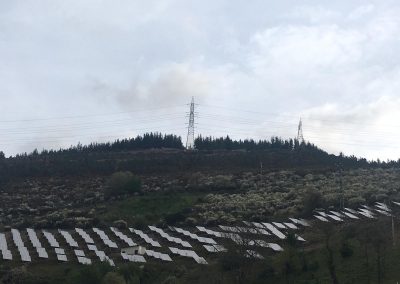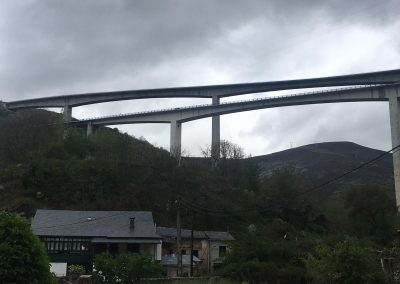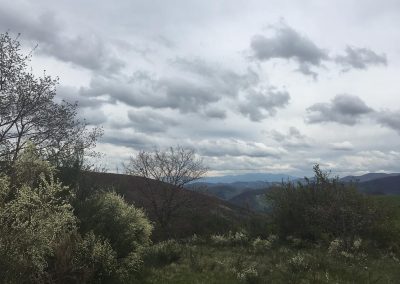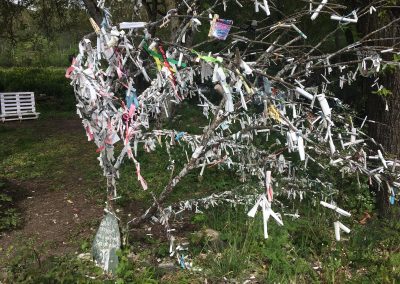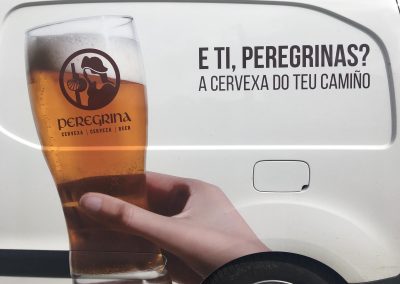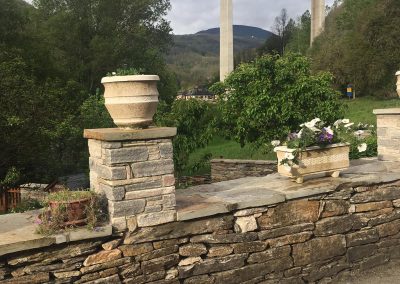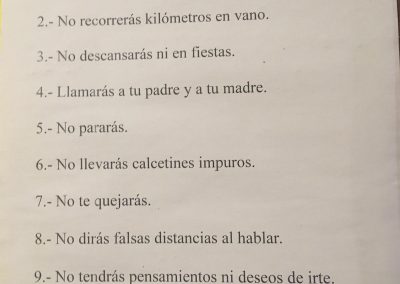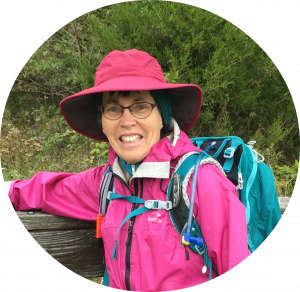
Trying on monastery life for size
Wednesday, mid-day (May 1) through Saturday, 9:40 am (May 4)
A postscript for starters. Why not mix things up a bit? (Who’s boss of this blog, anyway?)
So here’s the thing: it is Thursday, May 9. A whole week has gone by since I arrived at Rabanal del Camino. A bit more than a week. In the interim I have moved forward more kilometers than I care to count, and I find myself now in an albergue from whose windows I can see the huge monastery of Samos, my destination on this day. My thinking had been: if one stay in a monastery town is good, two should be even better. Plus, maybe my short walk to Samos will leave me with the time needed to catch up and write this post about Rabanal.
And to compare the two experiences, right?
Ah, but there is no comparison to be had! Well, alright then, compare and contrast. Uh! Sounds like a Composition 101 assignment. Don’t hold me to any standards I should have learned way back when. Just let me quickly say that Samos is a disappointment. Or “Samos as an experience of monastic life” is a disappointment.
I’m about to head over to the church now for the 7:30 mass. With little enthusiasm. I hope I’m proven wrong. I learned on my tour of the monastery about seven hours ago that
- The monastery does not open it doors to the public for their vespers or morning prayer or any other prayer times, just the mass
- The monks no longer sing Gregorian chant. (They gave it up a couple of year ago because they are so few–there are 8 of them–and because some of the monks are too elderly to join with the others downstairs in the church, so they say their private office in a chapel closer to their living quarters.)
So, I have quickly come to see that Samos is not going to be a “Rabanal” experience. Really, I see now that I might have skipped it. But then I would have missed the lovely walk that brought me here–the Samos destination is an “alternate” route–and the lovely walk I had after lunch along the river here.
And I wouldn’t have known about this monastery, and really, it’s pretty neat to think that for over 1500 years there has been a form of monasticism in this little lost valley between the mountains. In spite of the Visigoth invasion, the Moorish invasion, the many “kingdoms” that fought each other through the centuries. And we’re talking about what grew to be a very, very large monastery.
I asked the guide today how many monks lived here at the “peak.” That was, I think she said, in the 1700s, and the answer was: “80 or 90.” Counting the novices and other groups she mentioned–in very rapid Spanish!–as many as 250 men. And now… 8!
Well, here’s what I hope for them: that it is a lot warmer in their living quarters than it is in the church and the cloisters we toured; that they are fonder of one another than they appeared at this evening’s mass (from which, as I write this, I have now returned…), that they don’t drown under the responsibility of trying to keep the monastery vibrant with no support, as I understand it, from church or state (the 5-euro tour tickets and sales at the monastery shop must have to really be stretched far to keep the place afloat. To heat it to boot? Forget it!).
Now let me try to back up to last week’s stay in Rabanal del Camino which is the story I am really here to tell tonight (and perhaps over the course of the next few days, as I find spare minutes….).
Greetings and settling in
As I described in another post (see “And it only took me four hours,” May 1st), I took my time traveling the seven miles from Santa Catalina de Somoza to Rabanal del Camino, meeting a number of out-of-the ordinary individuals along the way. I arrived with both a light and an open heart. I located the monastery’s little square just off the Camino route and some pilgrims gestured to a man in a plaid shirt, telling me he was the one I wanted to see if I had questions about the monastery. That plaid-shirted man, maybe 50-something, was Father Javier, the prior–head monk–at the monastery. No sooner was he pointed out to me than he slipped into a building on the square, leaving the door slightly ajar as he entered. I followed quickly.
As it turns out, that door led to the monastery’s albergue for pilgrims such as myself. I have spoken thus far about “the monastery,” but this might be the time to tell you that I use the word “monastery” to refer to three things. The first is the building I had just entered; it houses up to 10 pilgrims at a time. Or maybe 12. I didn’t actually count the number of beds, but I know the monks want to keep the number small. Then there is the building which houses the four Benedictine monks and which, I assume, wouldn’t hold but a few more. This residence, you might say, is the actual monastery. Unlike Samos which was established in the 6th century, this one was formed, I believe, in 2002 because the Benedictine monks from Germany wanted to establish a presence on the Camino. If I’m remembering correctly, there was a former building on the site, but it was remodeled and modernized significantly. The third building is the small romanesque-style church, the oldest part of it built in the 12th century, with additions, modifications, and renovations completed in subsequent centuries. (Don’t let the word “renovation” fool you; this church oozed medieval times!) The very modern innovations (improved lighting and PA system) were done tastefully and enhanced the experience rather than detracting from it. So: three buildings. It has just been easier, until now, to refer to “the monastery.”
Back,then, to Father Javier who had just entered the pilgrims’ living quarters with a South Korean pilgrim (John, by name). “Ah, you are Katy?” Fr. Javier continued: “The one who emailed us, yes? We’ve been expecting you. It may be just the two of you tonight. You know, this is the first day of the season that we are accepting pilgrims.”
What?! I hadn’t known at the time I had written to the monastery that they didn’t accept pilgrims until May 1. In his reply, Fr. Javier hadn’t said anything about that. He had just told me that they didn’t take reservations, but that “it shouldn’t be a problem.” I found it to be an incredible piece of luck that my timing coincided with the monastery’s.
“Actually,” he went on, “there was a large group here last night. We don’t take groups, but we made an exception. So things are a little disorderly right now. We’re happy to keep it small for starters.”
Happy, yes, because the hospitalero who was to arrive for his (or her?) early May volunteer gig had been in touch just a few days back to let the fathers know that he was sick and wouldn’t be able to make it. That meant that the monks themselves would have to be the ones washing sheets, making beds, cleaning toilets, fixing, serving, and cleaning up from meals, plus washing pilgrims’ clothes, none of which are tasks they usually perform.
“But it’s okay. We will be fine. Let me show you everything but the living quarters first. That’ll give time for the floors to dry, and then you can settle in to your room.” So he showed us the lovely little enclosed garden, the kitchen where would would be served breakfast between morning prayer and mass, the library-lounge where we were welcome to use any of the books, and the upstairs meditation room (skylight, throw rug, meditation pillows on floor). And then, finally, the bathroom and the one large bedroom with two partial walls and big cupboards/closets in which to store our things. (“Floors get mopped every day, so nothing should be left on the floors,” we were instructed.)
Fr. Javier explained that we were there “to rest.” That we shouldn’t offer to help because that wasn’t our job. We weren’t to wash our clothes; they would take care of that. “Do what you need for yourselves,” he counseled. We had shown up too late to have been included in the lunch count for the 1:55 pm meal, but we should plan on having the evening meal with Fr. Javier and the other monks. Someone would come to collect us. He showed us a printed schedule for the three daily meals, the three prayer times open to the public in the little church, and the mass time, and mentioned that we could also request consultation times with any of the staff. And off he went, having put around each of our necks a key to the front door of our albergue, the door to which automatically locked when shut.
It was quite clear to me and to John: this was a sweet deal. I’m not referring to the price (which was “donativo”–give what you can and what you think appropriate), but rather to the facilities–very new, very clean, very comfortable and inviting–and to the kindness, good will, and hospitality which were so prevalent in the little tour Fr. Javier gave us.
And you’re thinking: at this rate this story will never be told? You might be right!
Getting down to the business at hand
Which for me meant: filling the empty spot in my belly. El Refugio, not thirty feet from my new front door, was exactly the place to do that.
Have I explained how I learned about the monastery in the first place? When Ginny bussed ahead into León and took up residence in an Airbnb there, Roberto was her “host.” Roberto, it turns out, has connections in Rabanal. He had told Ginny about those connections and, when I met him during my one night at his place in León, he brought them up again. Roberto is a consultant for a hotel and restaurant in Rabanal. It’s a business that has been in the same family for several generations, but Roberto has been hired to help them move into the 21st century with their menus, their presentation of the food, their marketing, etc., etc. He has also worked some with the monks, checking out their willingnesss to get on board with his idea of bringing people to Rabanal (and to El Refugio’s hotel) to begin their Camino). His idea: maybe give people the opportunity to stay in the town a few days, get some one-on-one counseling with the monks, attend the services in the church, all while getting excellent meals (vegan, vegetarian, “new age” food appearing on the menu along with local specialties….)
So yes, it was because of Roberto that I had learned of the monastery I had just committed to staying in for at least two nights (that’s one of the rules for the monastery’s albergue, that pilgrims will stay at least two nights and will consider their stay a kind of silent retreat; if you aren’t interested in “things of the spirit” [and if you don’t have a pretty decent handle on English], you aren’t a good candidate for the monastery experience).
It was kind of a “must,” then, that I look into El Refugio as well. Besides, the restaurant offered cocido maragato [a rich meat stew prepared in the “maragato” style of this region through which I was traveling and a dish about which I had been hearing]. So, splurge that it was and feeling not very “monk-like”–sticking to a simple lifestyle, for example–that is what I ordered. And consumed. Every bite. Even the pigs’ ear!
After which: I began to “rest” as we had been ordered to do. I had four “rests” of the sort that I am now going to describe. Now some people sleep to rest, or sit back in their easy chairs; I walk. Fr. Javier had pointed out a notebook in the library in which were descriptions (in German and in English) and accompanying maps of eight different walking routes accessible from the monastery. The descriptive sheets gave the estimated time of each walk, varying from one hour to two-and-a half. I pored over the descriptions, extracted several of them, along with their corresponding maps, from the notebook, threw a few things in my small backpack, and off I went.
As mentioned, I did four such walks: one on Wednesday afternoon, two on Thursday, and a final one on Friday afternoon. These were some of the most delightful times I have had on this trip. Pure country, if you know what I mean. I wasn’t following yellow arrows, wasn’t going where hundreds of thousands have already gone, but was traipsing up the narrowest of paths “into the hills” or down “into the valleys” with a sense of freedom and a spirit of adventure. And with a camera, for the sights were so impressive. Before all was said and done I had gone to the monastery’s “park,” to its “woodlands” and twice to magnificent overlooks, one above and west of the village, one above and east. On the latter, I carried in my little pack two books I’d borrowed from the library: I wanted the Bible for the psalms and the book of Antonio Machado’s poetry… I just couldn’t resist. (Think Spain’s Robert Frost or Mary Oliver.) I spent some wonderful time seated on a stone throne high in the hills, overlooking pastures with cows and not one but two near-empty villages in the distance while I alternated staring in awe and reading poetry written by awestruck poets. It doesn’t get much better.
And yes, I sang! And yes, I became a bit panicky on one of the hikes. I got a bit mixed up on the directions, couldn’t interpret the printed map, didn’t recognize the “rectangular corner” in the field behind Farmer Juan’s garden where I was supposed to see the towering willow and head into the monk’s woodland…. Before I knew it, I was very confused while trying to make it back to church for vespers, and I found myself in way-above-the-knee “broom” and/or gorse, not sure if I was going the right direction. I could have done without that particular hike. The others? Fabulous. Best “silent retreat” ever! I wish you could have been there, truly.
And that’s how I spent my free time. A little bit of wandering around the tiny town. Quite a few minutes spent just outside El Refugio, capitalizing on their WiFi as, in fact, the monastery’s albergue didn’t have it, the monks figuring that it wasn’t conducive to “silent reflection.” Both Thursday and Friday mornings, while waiting for the days to warm up, I worked on blog posts since I was a couple of days behind. (If you noticed a couple of posts that had fewer typos than usual, those were no doubt the ones written and actually edited/revised on those two mornings. My walks up and down the main streets of this small village revealed a few fun and funky places, like the “Green Park” where a sign read: Free Entrance and which had hammocks and lounge chairs and a couple of sofas under canopies. It also had perhaps as many as a dozen tents set up, available for pilgrims to rent, I assume. The whole place looked kind of 60s style. I stayed away from groups and socializing, though had short conversations with my roommates who eventually included, besides John, Christine from France, Rainer from Germany, and Jiwon from South Korea.
I sent an email to Roberto back in León, thanking him for recommending Rabanal to me. His response indicated that he would be in town working at El Refugio on Friday and that, if I were still in town, perhaps we could have coffee together. And so we did, on Friday afternoon. He told me more about his work and his enthusiasm for promoting Rabanal as a “starting point” for pilgrims wanting a shorter version of the Camino. Turns out that his girlfriend is a big promoter of the Camino as well, organizing “section” or “etapa” [“stage”] tours for people who want more of a “soft version” of the Camino. When we met for coffee, Roberto suggested a hike for me to take, but in trying to follow it, the barking of one particular dog encouraged me to turn around. This was a blessing because it led to my climbing up to the precious overlook that I described earlier where I sat and read psalms and poetry.
The rest of the time? The scheduled meals, prayers, and masses.
Meals and Mendelssohn
So far you’ve only heard about Fr. Javier, who, I neglected to mention earlier, is a native Spaniard. It was at the first dinner, on Wednesday night, when I met Brother Leandro (a young–30-something?–monk from Venezuela) and Father Pío, in his 70s, I would say, from Germany. (The hike descriptions were his doing; very poetically written. He told me he grew up on a farm and has always loved gardening and being out in nature. His handiwork is evident in the monk’s various gardens.). The fourth monk, Fr. Clements from Korea, returned from vacation on Friday and so he, too, became part of our “family.” Apparently Fr. Clements is very well known–at least among Catholics who make up approximately 8% of the Korean population. John said he “knew” him from television. It explains one of the reasons why so many Koreans want to stop at the monastery. However, as Fr. Javier explained, they have placed a limit on how many Koreans can stay at one time: just two! It seemed that several times before that policy was instituted, there were instances when all but one or two guests were Korean. Some with very limited English skills. It made it very difficult for the non-Koreans. Fr. Javier said that without the restriction, they might be entirely filled with Koreans each night.
In all, I ate three breakfasts, two lunches, and three dinners during my monastery visit. The lunches and dinners were taken in the monks’ residence and we were cautioned ahead of time that these were “silent times.” Indeed they were! (Or weren’t, as I’ll get around to explaining in a minute. Be patient.) There was, true, no talking. Zilch. A gesture here, another there, as we offered each other the bread basket or a bit more water. That sort of thing. Otherwise, though, our focus was pretty much straight ahead or on our food. This was awkward for the first meal or two, but each time it became a bit easier. I was there long enough to fall into the routine and to even find it (somewhat) comforting.
Before we sat down to lunch, Fr. Pio read from the Book of Revelations. (I imagine they work their way through the Scriptures and I just happened to be there to hear the most difficult of all the books of the Bible.) After the short reading, we all sat down and, in the absence of a hospitalero, Fr. Javier was not only the cook but the waiter. His entrances and exits were nothing short of a synchronized ballet, performed with a flourish and in a rhythm that was fun to observe (out of the corner of one’s eye, because…. well, because it seemed appropriate to follow the example of the other monks who kept their vision straight ahead). Everything Fr. Javier did was predictable once I had learned the “routine,” everything from the way he removed the three pitchers of water at the same time to the way he collected the glasses and the plates, the water and wine glasses and the bread baskets. Everything as if on cue.
While we ate: music! Classical music. It was “Mendelssohn week,” I was told (after dinner, because, as stated, no talking during meals!). An opera here, a piano concerto there. I eventually recognized a piece or two. So, “silent”? Not exactly.
The meals themselves: very tasty. Very tasty indeed. One would not, however, gain weight on them! If a pilgrim wanted seconds, he or she would be wise not to hesitate to dish them up before the bowl was wisked away from the table. In the evening, expect a lighter meal. Don’t hold back unless you want to supplement your meal in one of the town’s cafes. Fr. Javier added some interesting touches to the salads, bits of apple and pear surprising me in the cold lentil dish or in the salad.
I was lucky: there were three tables which formed a big U-shape, and I was always seated on the only side that faced a window, so besides seeing Christine and Reiner across from me, I could look out onto the patio. The scene I’ll now describe was kind of humorous: at one meal, Brother Leandro was seated next to me. I had noticed, when he was sitting at another of the tables, the degree to which he stared straight ahead when not eating. Very disciplined! So at this particular meal when he was sitting next to me, out the window I caught sight of a bird on a bush. I swear, the bird’s tail was keeping time with the Mendelssohn music! For at least a minute. Perfect timing to the music! I couldn’t help myself–I took a sideways glance at Brother Leandro, to see if he was seeing what I was seeing. I can’t say that our eyes even met, but I knew that we were each attempting to hide the grin on our faces as we witnessed the same delightful sight.
So were they human, these monks? Incredibly so! Very dear indeed. Although there was no talk at lunch and dinner, after the former we would gather just outside the monastery to chat for a bit about our afternoon plans. It was a chance to ask questions or share a quick story. Brief but friendly. The evening meal was over about 8:40. We would then all proceed to a room that I’ll call the monastery “parlor” for some socializing until the bell rang (9:20) sending us scurrying over to the church for evening prayer and the pilgrims’ blessing. During those post-dinner gatherings we learned more about the monks, their work, and their interactions with pilgrims, or they learned a bit about us. Time to ask questions, tell tales, share a humorous story. Fr. Javier, for instance, enjoyed telling about one of the more zealous hospitalero volunteers. It seems that when the Abbott was visiting Rabanal with a contingent of other monks, he stopped by with his group and wanted (all of them) to enter to use the bathrooms. “You’ll have to go use a bathroom at one of the cafes,” the hospitalero told him. “I’ve jut finished cleaning them and I want them to stay clean for the next group of pilgrims.” That’s telling the Abbott where to go! There were laughs all ’round, even though the other monks had heard the story multiple times. And then: the bell rings and, regardless of whether a question has been thoroughly answered or a story fully told, that’s it: off to the prayer service we go.
Gregorian chant!
Yes, it is alive and well in Rabanal del Camino. For the first two days, just the three monks, with Fr. Javier always doing what I’ll name the “call” and Brother Leandro and Fr. Pio the “response.” (Sounds like square dancing, but no, we’re talking voices. Beautiful voices.) What I would call the “chants” themselves were always in Latin, but Spanish was used in some of the services. And, for that matter, English and Korean, French, German. The extra languages came into play when the monks asked visiting pilgrims to do some of the readings or the “prayers of the faithful.” I was impressed, as well, that there were booklets available for pilgrims for each of the daily services (Lauds at 7:30 am, Vespers at 7:00 pm, and Compline at 9:30), in a choice of English, French, or German. One for Korean speakers as well? Maybe. It would make sense. All the prayers very measured, very sacred. Not protracted in length, but not rushed either. And those voices! The echo of them in the small, bare church was so lovely. “Is being able to sing a requirement for monastic life?” I asked at one point. I was told it was not. (So, then, my singing–or total lack of talent in carrying a tune–did not automatically disqualify me; I didn’t pursue the problems endemic to my being a woman, married, and well into my 70th year. Didn’t want to hear too much laughter during our social times.)
You can understand, then, why I was disappointed with my experience at the Benedictine monastery of Samos. It had the 1500-year presence in that location, but, in my opinion, a lot of the “fire” had gone out in Samos.
Final farewells
Warm hugs distributed, Christine and Rainer were off early on Saturday morning; they wanted to get an early start on the climb to Cruz de Ferro. I elected to have one more breakfast and morning mass in Rabanal.
Jiwon had now been there for almost a full day. Three new pilgrims had already presented themselves by breakfast time. (I think they had arrived the day before and were told “Come back tomorrow. We will lose three people on Saturday and you can take their places.”) For some reason at breakfast I volunteered to sing–yes! Me!–one of my “prayer songs.” It was well received by all present (none of whom were native speakers of English). Brother Leandro asked if I would say that prayer when I arrived at Cruz de Ferro. “The ‘grace’ version of it or the ‘joy’ version?” I asked. “Oh, the latter!” And so, promising that I would do so, that kind of wrapped up my stay in Rabanal. I attended the 9:00 am mass, got strapped into my pack, picked up the hiking poles, and then I was off. I had a mission down the road! A song to sing!
(If you must know, I sang a couple of songs when I arrived at Cruz de Ferro several hours later. I recorded them but… trust me on this one: they sure couldn’t measure up to my recordings of the birds! In the end I did not send the recordings back to Rabanal to prove that I’d done what I’d been charged to do. I left my songs and my “joy” stone behind and kept my memories to bring them forward. And to share them with you.
And now I’ve done so.

